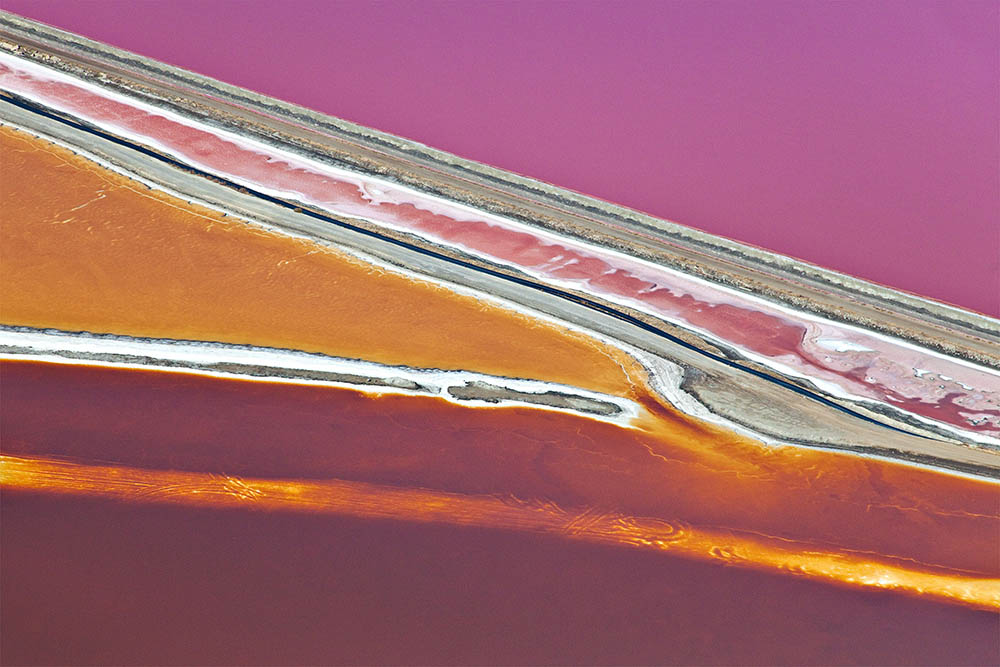Some viewers of my images from South San Francisco Bay have assumed the strong colours are water pollution. When these viewers discovered that wasn’t the case, I sensed some disappointment. Perhaps their assumption was conditioned by Ed Burtynsky’s images presented by the Whyte Museum in 2009, where one especially iconic image showed water colourfully stained by nickel mining residues.
The colors in my SF Bay images are the result of microorganisms, brine shrimp for the yellows, oranges, reds and magentas and algae for the greens and some yellows. The brine shrimp change colour depending upon the salinity of the water in the salt sloughs and evaporation ponds. When the water completely evaporates, the shrimp dry out and lose their colour. (Hmmm – do we get a helping of dried brine shrimp when we consume sea salt?)
Rather than pollution, the Bay images are coloured by billions of apparently happy, thriving brine shrimp plus algae. So what’s wrong with this picture?
There are two things wrong. First it’s a monoculture. That means the salt ponds are designed to exclude all forms of life except those that, Cargill, the company harvesting the salt can put up with. Second, over 80% of the original tidal wetlands, which once lined the shores of San Francisco Bay, have been eliminated by human developments like the extensive salt pond construction.
Of course we humans depend upon monocultures – think of Alberta’s extensive wheat fields – for our existence. Monoculture agriculture is one of the innovations that lead to the growth of civilization in the ancient world and sustains our world’s burgeoning population today. It becomes a problem when it eliminates so many habitats that species become endangered or extinct and the biodiversity of our world is threatened.
The San Francisco Bay shores are an important habitat for numerous species including many varieties of migratory birds. The dangers of the human monoculture, all seven million people who surround the Bay and their related developments, have been recognized. Environmental groups and governments have been working toward restoring some of the wetlands for decades. Today the largest wetland restoration project in the western US is underway. You can find out more at the South Bay Salt Pond Restoration website.
The salt pond images are thus symbolic of our modern dilemma – finding the balance between drawing on our planet’s resources and maintaining a healthy, vibrant earth that can sustain what we draw.
I did not set out to create my images with a good/bad agenda. If anything my agenda was to be as unbiased as possible. However in discussion with viewers who assumed an agenda, I was sharply confronted with the question, “Should fine art images be judged by the degree to which they seek out the good or the bad?” I found Joerg Colberg’s comments on this dilemma enlightening: “Uprooted from the real . . .”
“What’s the point of photography when you basically demand to see a certain outcome before the photographer gets to work? . . . Whether we like it or not our world has become considerably more complex over the past fifty years, and photographers adapting to that complexity – instead of striking simple/obvious poses – is one of the many consequences of this development. Ultimately, we all can only gain from this expanded breadth of photography, because it gives us more space to explore things, and to see them from more angles than just two (“good” versus “bad”).”
To be fair to Ed Burtynsky, I am not saying he seeks out bad things. He seeks big, impactful things and leaves the meaning to the viewer. I respect his position when he says: “I search for subjects that are rich in detail and scale yet open in their meaning.”
Tags: Good/Bad, Salt Ponds, San Francisco Bay
